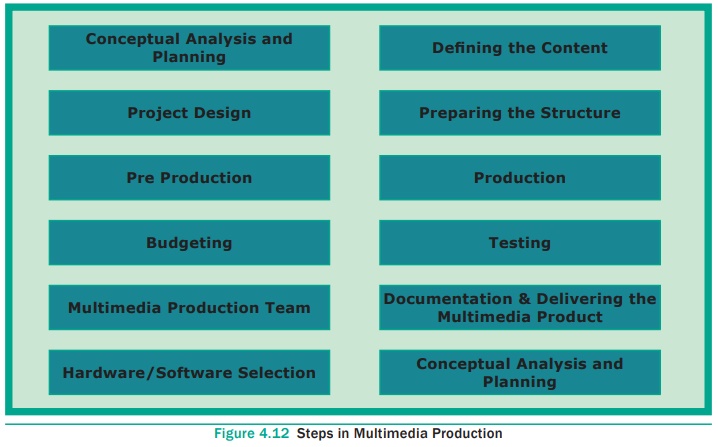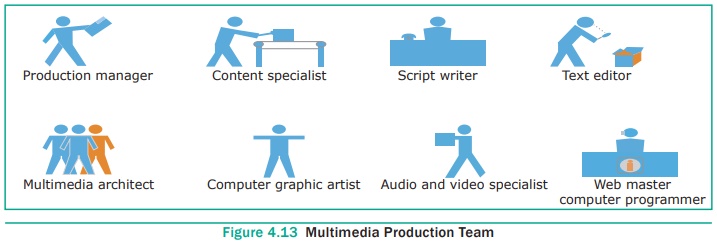Multimedia and Desktop Publishing - Multimedia Production | 12th Computer Technology : Chapter 4 : Multimedia and Desktop Publishing
Chapter: 12th Computer Technology : Chapter 4 : Multimedia and Desktop Publishing
Multimedia Production
Multimedia Production
Steps in Multimedia Production
Adequate time and efficient planning is required for multimedia
production, which assures that the project will be proceed smoothly and
certainly ensures that the information reaches the target audience. Following
are the phases for development of complex multimedia projects.
1. Conceptual Analysis and Planning
The process of multimedia making begins with a conceptual ignition
point. Conceptual analysis identifies a appropriate theme, budget and content
availability on that selected theme. Additional criteria like copyright issues
also are considered in this phase.
2. Project design
Once the theme is finalized objectives, goals, and activities are
drawn for the multimedia project. General statements are termed as goals. The
specific statements in the project is known as the objectives. Activities are
series of actions performed to implement an objective. These activities
contribute to the Project design phase.
3. Pre-production
Based on the planning and design, it is necessary to develop the
project. The following are the steps involved in pre-production:
4. Budgeting
Budgeting for each phases like consultants, hardware,
software,travel, communication and publishing is estimated for all the
multimedia projects.
5. Multimedia Production Team
The production team for a high-end multimedia project requires a
team efforts. The team comprises of members playing various roles and
responsibilities like Script writer, Production manager, Editor, Graphics
Architect, Multimedia Architect and Web Master.
6. Hardware/Software Selection
All multimedia Application requires appropriate tools to develop
and playback the application. Hardware includes the selection of fastest CPU,
RAM and huge monitors, sufficient disc for storing the records. Selection of
the suitable software and file formats depends on the funds available for the
project being developed.
7. Defining the Content
Content is the “stuff ” provided by content specialist to the
multimedia architect with which the application is developed, who prepares the
narration, bullets, charts and tables etc.
8. Preparing the structure
A detailed structure must have information about all the steps
along with the timeline of the future action. This structure defines the
activities, responsible person for each activity and the start/end time for
each activity.
9. Production
In the multimedia application, after the pre-production
activities, the production phase starts. This phase includes the activities
like background music selection, sound recording and so on. Text is
incorporated using OCR software, Pictures shot by digital camera, Video clips
are shot, edited and compressed. A pilot project is ready by this time.
10. Testing
The complete testing of the pilot product is done before the mass production to ensure that everything is in place, thereby avoiding the failure after launch.

If it’s an web based product, its functioning is tested with different browsers like Internet
Explorer, Chrome, Mozilla and Netscape Navigator. If it is a local multimedia
application on a LAN it must be deployed in the server for testing purpose.
After the testing process are over, the product is incorporated with valid
suggested changes.
11. Documentation
User documentation is a mandatory feature of all multimedia
projects. The documentation has all the valuable information’s starting from
the system requirement till the completion of testing. Contact details, e-mail
address and phone numbers are provided for technical support and sending
suggestions and comments.
12. Delivering the Multimedia Product
Multimedia applications are best delivered on CD/DVD or in the
website . In reality various challenges are faced while delivering through
internet, like bandwidth problems, huge number of plug-ins required to play
audio and video and long downloading time. Finally, a multimedia application is
delivered in a more effective way by the integration of two mediums CD-ROM/DVD
and Internet.
Multimedia Production Team
Managing team members in a way to get maximum outcome with high
degree of efficiency is mandatory in multimedia production. The fine quality
high-end multimedia production application requires a specialize team comprises
of the following members:
1. Production Manager
In a multimedia production, the role of production manager is to
define, and coordinate, the production of the multimedia project in time and
with full quality. The production manager should be an expertise in the
technology expert, good at proposal writing, good communication skills and
budget management skills. Also must have experience in human resource
management and act as an efficient team leader.
2. Content Specialist
Content specialist is responsible for performing all research
activities concerned with the proposed application’s content. Program content
refers to projects information, graphics, data or facts presented through the
multimedia production.
3. Script Writer
Video and film scripts represents a linear sequence of events. The
script writer visualizes the concepts in three dimensional environments and if
needed uses the virtual reality integration into the program.
4. Text Editor
The content of a multimedia production always must flow logically
and the text should always be structured and correct grammatically. Text and
narration is an integrated part of the application.

5. Multimedia Architect
The multimedia architect integrates all the multimedia building
blocks like graphics, text, audio, music, video, photos and animation by using
an authoring software.
6. Computer Graphic Artist
The role of Computer Graphic Artist is to deal with the graphic
elements of the programs like backgrounds, bullets, buttons, pictures editing,
3-D objects, animation, and logos etc.
7. Audio and Video Specialist
The roles of these specialists are needed for dealing with
narration and digitized videos to be added in a multimedia presentation. They
are responsible for recording, editing sound effects and digitizing.
8. Computer Programmer
The computer programmer writes the lines of code or scripts in the
appropriate language. These scripts usually develops special functions like
developing the software to give the size and shape of video windows,
controlling peripherals and so on.
9. Web Master
The responsibility of the web master is to create and maintain an
Internet web page. They converts a multimedia presentation into a web page.
Final multimedia product is ready for consultation is a joint effort of the
entire team. Initially, the production manager identifies the project content,
while the web master provides access to a wide range of community through
web-services.
Related Topics